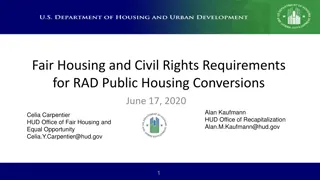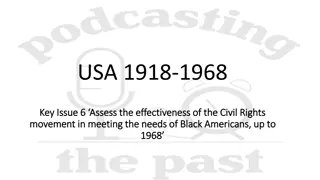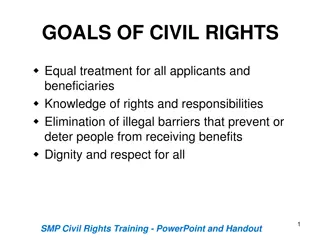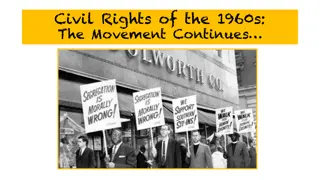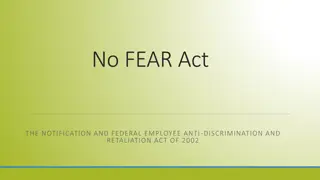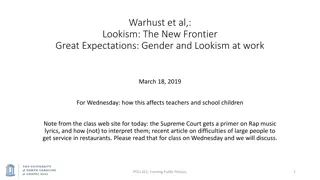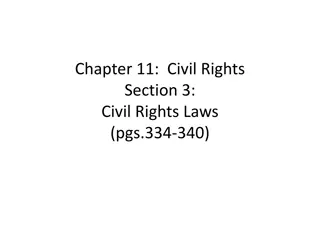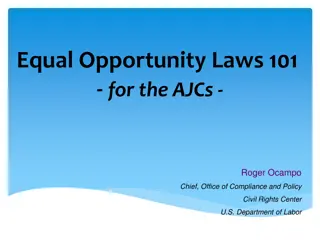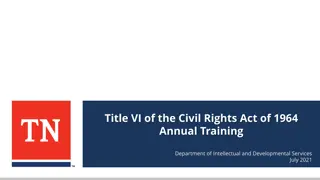Understanding Title VI of the Civil Rights Act
Title VI of the Civil Rights Act of 1964 prohibits discrimination on the basis of race, color, or national origin in programs receiving federal financial assistance. This act outlines the obligations of state agencies and recipients of federal funds to ensure equality and non-discrimination. The training instructions require all relevant staff to review the provided PowerPoint training, answer questions, and sign a Certificate of Completion. Tennessee state law further strengthens the prohibition of discriminatory practices based on race, color, or national origin. While not focused on employment discrimination, Title VI does address such issues in specific situations.
Download Presentation

Please find below an Image/Link to download the presentation.
The content on the website is provided AS IS for your information and personal use only. It may not be sold, licensed, or shared on other websites without obtaining consent from the author. Download presentation by click this link. If you encounter any issues during the download, it is possible that the publisher has removed the file from their server.
E N D
Presentation Transcript
Title VI of the Civil Rights Act of 1964
Required Title VI Subrecipient Training Instructions: Subrecipients/grantees of the Agency must have all relevant staff review the attached PowerPoint training individually or as a group. This training is adapted from the TN Department of Human Resources Title VI Training. It takes 5 questions at the end of the PowerPoint about the topics covered in the presentation and includes the answers to the questions on the following slides. After reviewing the training each staff member should sign and date the Certificate of Completion and send a copy of each staff members certificate to Jennifer Jones, Title VI Coordinator for the Tennessee Commission on Children and Youth. Email: Jennifer.n.jones@tn.gov Fax: 615741-5956 Mail: Tennessee Commission on Children and Youth, Andrew Jackson Building, Ninth Floor, 502 Deaderick ST, Nashville, TN 37243
Course Outline Overview of Title VI Theories of discrimination LEP/National Origin State agency obligations
What is Title VI of the Civil Rights Act of 1964?
What is Title VI? Title VI prohibits discrimination on the basis of:
Federal Law 42 U.S.C. 2000d provides, No person in the United States shall, on the ground of race, color, or national origin, be excluded from participation in, be denied the benefits of, or be subjected to discrimination under any program or activity receiving Federal financial assistance.
Tennessee Law Tenn. Code Ann. 4-21-904 It is a discriminatory practice for any state agency receiving federal funds making it subject to Title VI of the Civil Rights Act of 1964, or for any person receiving such federal funds from a state agency, to exclude a person from participation in, deny benefits to a person, or to subject a person to discrimination under any program or activity receiving federal funds, on the basis of race, color, or national origin.
Scope of Coverage - Employment While Title VI was not meant to be the primary vehicle to prohibit employment discrimination, it does forbid employment discrimination by recipients in certain situations.
Title VI and Employment Discrimination If a primary objective of the Federal financial assistance to a recipient is to promote employment, then the recipient s employment practices are subject to Title VI. Otherwise, refer to Title VII of the Civil Rights Act of 1964, which covers employment discrimination based on race, color, national origin, religion, and sex. This is addressed in the State s Policy on Workplace Discrimination and Harassment.
What must occur for Title VI to apply? The program or activity Must be located in the United States Must provide a service Must receive direct (recipient) or indirect (sub-recipient) federal financial assistance
What is Federal Financial Assistance (FFA)? Award or grant of money; Loans, below fair market value subsidies; Any federal agreement, arrangement, or other contract which has as one of its purposes the provision of assistance; Surplus property; Training; and Detail of federal personnel.
What is a recipient? A recipient receives FFA and/or operates a program or activity (e.g. a state, local or municipal department/ agency, or other entity) Subrecipient Primary Recipient - Distributes assistance to an ultimate beneficiary (e.g., contractors, subcontractors or grantees) Transfers or distributes assistance to another recipient or subrecipient
Beneficiaries Individuals and/or entities who directly or indirectly receive an advantage through the operation of a federal program.
Examples of discriminatory practices Denying an individual any service, financial aid, or benefit. Providing a different service, aid or benefit, or providing them in a manner different that they are provided to others. Segregating or treating individuals separately in any manner related to receiving programs, services, or benefits. Retaliation. National Origin/Limited English Proficient (LEP) Discrimination.
Disparate Treatment Intentional discrimination against an individual. Must show that a challenged action was motivated by an intent to discriminate.
Evidence of Discriminatory Intent May be direct or circumstantial and may be found in various sources, including statements, historical background of events in issue, or a departure in standard procedure
Elements of Disparate Treatment The aggrieved person was a member of a protected class; That person applied for, and was eligible for a federally assisted program that was accepting applicants; That despite the person s eligibility, s/he was rejected; and The recipient selected, or continued to accept applicants of the complainant s qualifications.
Disparate Treatment Once the elements are established, the recipient has to show there was a legitimate, nondiscriminatory reason for the challenged action. It is then up to the investigating agency to determine whether there is sufficient evidence to establish that the recipient s reason was a pretext for discrimination.
Disparate Impact Discrimination that occurs as a result of a neutral policy which appears harmless on the surface, but negatively affects a group. Focus concerns the consequences of a recipient s practices, rather than intent.
Elements of Disparate Impact The recipient s facially neutral policy or practice caused a disproportionate and adverse effect on members of a protected class Requires a comparison of the effects of the policy or practice on the relevant protected class relative to the effects on others May be shown through statistics or other evidence of a significant adverse impact upon the relevant protected class
Disparate Impact After the elements are established, the investigating agency must then determine whether the recipient can articulate a substantial legitimate justification for the challenged practice.
Substantial Legitimate Justification To prove, the recipient must show that the challenged policy was necessary to meet a goal that was legitimate, important, and integral to the recipient s institutional mission.
Disparate Impact If the recipient provides a substantial legitimate justification, the inquiry then focuses on whether a less discriminatory alternative was available.
National Origin/ Language Discrimination
Who is a Limited English Proficient Person? Persons who do not speak English as their primary language and who have limited ability to read, speak, write or understand English LEP = Limited English Proficiency These individuals may be entitled to language assistance with respect to a particular type of service, benefit or encounter
National Origin/Language Discrimination The Supreme Court in Lau v. Nichols, 414 U.S. 563 (1974) provided that failure to provide information in languages other than English could result in discrimination on the basis of national origin where failure to do so results in a significant number of LEP beneficiaries being unable to fully realize the intended benefits of the federally assisted program or activity.
Basic Principle Provide meaningful opportunity to access a program or activity
Executive Order 13166 (2000) Presidential order that required each federal agency to develop LEP guidance that sets forth compliance standards recipients must follow to ensure that programs and activities that are normally provided in English are accessible to LEP persons.
Four Factor Analysis The number or proportion of LEP persons in the eligible service population; The frequency with which LEP individuals come in contact with the program; The importance of the service provided by the program; and The resources available to the recipient.
Retaliation Occurs when a recipient or another person intimidates, threatens, coerces, or discriminates against any individual for the purpose of interfering with any right or privilege secured by Title VI, or because a person made a complaint, testified, assisted, or participated in any manner in an investigation or proceeding under Title VI.
Elements of Retaliation The complainant was engaged in a protected activity; The recipient knew of the complainant s protected activity; The recipient took some adverse action against the complainant; and There was a causal connection between the protected activity and the adverse action.
Retaliation Once the elements are established, the recipient must show it had a legitimate, non-discriminatory reason for the action. The investigating agency must then determine if the recipient s reasons were pre-textual.
Filing a complaint There is a 180-day statute of limitations Individuals may file a complaint with the Agency Title VI Coordinator Tennessee Human Rights Commission U.S. Department of Justice
Bottom Line!!! Simple justice requires that public funds, to which all taxpayers of all races contribute, not be spent in any fashion which encourages, entrenches, subsidizes, or results in racial discrimination. (President John F. Kennedy, in his message calling for the enactment of Title VI, 1963)
Assess Your Understanding
Please take a few moments to answer the following review questions to assess your understanding of Title VI of the Civil Rights Act of 1964. Once you have selected your answer choice, advance to the next slide to see the correct response for each question. If you need further guidance on Title VI and its implementing regulations, please contact Jennifer Jones, TCCY Title VI Coordinator for the Agency, at Jennifer.n.jones@tn.gov or 615.532-1592.
Assess Your Understanding 1. Which of the following is not a protected class under Title VI? A. Race B. Sex C. National Origin D. Color
Assess Your Understanding 1. Which of the following is not a protected class under Title VI? B. Sex If you chose answer B, excellent! Title VI prohibits discrimination on the basis of a person s race, color, or national origin. Sex is not a protected class under Title VI.
Assess Your Understanding 2. Which statement is true? A. Disparate treatment occurs when a discriminatory practice is motivated by intent. B. Disparate treatment occurs as a result of a neutral policy which appears harmless on the surface, but negatively affects a group.
Assess Your Understanding 2. Which statement below is true? A. Disparate treatment occurs when a discriminatory practice is motivated by intent. A is the correct answer! A claim of disparate treatment must show that an individual acted with intent or motive to discriminate.
Assess Your Understanding 3. For Title VI to apply, the agency must be: A. Providing services to individuals in poverty B. A non-profit/501(c)(3) C. A direct recipient of state funding D. Either a direct or indirect recipient of federal funding
Assess Your Understanding 3. For Title VI to apply, the agency must be: D. Either a direct or indirect recipient of federal funding The correct answer is D! For Title VI to apply, the agency must either be a direct or indirect recipient of federal financial assistance.
Assess Your Understanding 4. Who is a Limited English Proficient person? A. A person who does not speak English as their primary language and has limited ability to speak, write, or understand English B. A person from the United States who cannot read C. A person who does not speak English at all D. Answers A and C
Assess Your Understanding 4. Who is a Limited English Proficient person? D. Answers A and C Limited English Proficient (LEP) persons are people who do not speak English as their primary language and who have limited ability to read, speak, write or understand English
Assess Your Understanding 5. True or False: Under a Limited English Proficiency (LEP) policy, only direct recipients of federal funding must take steps to ensure that all non-English speaking persons receive the same access to program benefits.
Assess Your Understanding 5. True or False: Under a Limited English Proficiency (LEP) policy, only direct recipients of federal funding must take steps to ensure that all non-English speaking persons receive the same access to program benefits. False Direct recipients and sub-recipients of federal financial assistance are required to take reasonable steps to ensure LEP persons have meaningful access and an equal opportunity to participate in programs, services, and benefits.
Great Job!!! You have completed the Title VI training course. Please sign your Certificate of Completion and return to the Tennessee Commission on Children and YOuth Title VI Coordinator Jennifer Jones by emailing to Jennifer.n.jones@tn.gov You can also fax the certificate(s) to 615.741-5956 or mail to: Tennessee Commission on Children and Youth Andrew Jackson Building, Ninth Floor 502 Deaderick ST, Nashville, TN 37243


